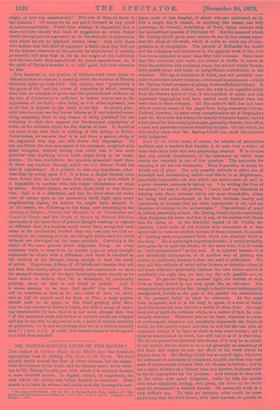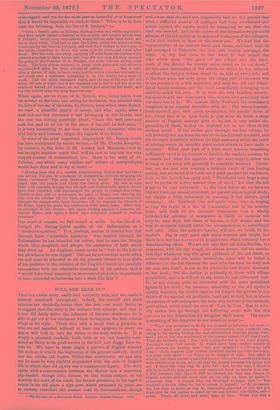MR. BARING-GOULD'S LIVES OF THE SAINTS.* TnE author of Curious
Myths of the Middle Ages has found an appropriate task in writing The Lives of the Saints. We have already briefly noticed the first of these volumes, .but the magni- tude and interest of the work, and the literary merit, never want- ing to Mr. Baring-Gould's pen, with which it is executed demand a more detailed review. Iu regard, indeed, to magnitude, the task which the author sets before himself is enormous. Each month is to have its volume, and under each day is ranged a cata-
* The Lines of the Saints. By the Rev. S. Baring-Gould. M.A., Author of "The Origin and Development of Religious chef," .1m. Vols. I. and IL London: John Bodges. 1872.
logue, more or less lengthy, of saints who are celebrated on it. Not a single day is vacant, or anything like vacant, one holy personage, St. Oswald, Archbishop of York, being content with the intermittent honours of February 29. But the names of which Mr. Baring-Gould gives some notice do not by any means repre- sent the whole of his work, which is quite as much one of com- pression as of compilation. The labours of Bollandus the Jesuit and his colleagues and successors in the gigantic work of the Acta Sanctorum extended to more than fifty folio volumes. Since their day, two centuries and more, not indeed so fertile in saints as were the primitive and medieval times, but yet not wholly barren, have passed away, and made no insignificant contribution to the calendar. The age is intolerant of folios, and will probably con- sider the thirteen octavo volumes—twelve and a supplement—which Mr. Baring-Gould proposes as giving limits sufficiently liberal. It would have been well, indeed, were the work to be regarded solely from the literary point of view, if the rejection of minor and less important biographies had been carried much further than has been done in these volumes. All the author's skill has not been able to prevent many of the pages from being somewhat tedious. Tedious, however, in parts every comprehensive set of biographies must be; the reader has always his remedy in his own hands; and he must remember that many personages, generally obscure, have often a local and particular interest attaching to them. On the whole, he will readily allow that Mr. Baring-Gould has made his selection with judgment.
Lives of the Saints must, of course, be brimful of miraculous incident, and a reader's first impulse is to note how a writer of these days deals with this very perplexing element. It is obvious that any critical examination of the testimony on which these events are recorded is out of the question. The materials for carrying it out are not obtainable. Were it possible, it Would be wholly out of place. The only possible attitude is either one of thorough and unhesitating belief—and this is, to an Englishman, practically impossible—or that which our author aims at, and, in a great measure, succeeds in taking up. " In writing the lives of the saints," he says in his preface, "I have used my discretion in relating only those miracles which are most remarkable, either for being well authenticated, or for their intrinsic beauty and quaintness, or because they are often represented in art, and are therefore of interest to the archeologist." This attitude of mind is, indeed, essentially critical. Mr. Baring-Gould rejects continually what displeases his taste, and few, if any, of his readers will blame him for doing so. In the beautiful legend of St. Vitalis, for instance, which some of our readers may remember as it was lately told in verse in another portion of these columns, he speaks of "putting aside some absurd fable which has attached itself to the story." He is quite right in putting it aside ; it would probably have gone far to spoil the whole ; at the same time, it is of course as " well authenticated" as the rest. It is rejected because it is not artistically harmonious, or if another way of putting the matter be preferred, because it does not tend to edification. We may call this attitude of mind either literary or didactic—there is not much difference practically between the two terms—and it is manifestly the right one, we may say the sole possible one, to assume. To put the thing in another light, the writers of such lives as these should in one way speak like an advocate. The recognised etiquette of the Bar, though indeed it is not unfrequently transgressed, forbids as the part of the pleader the asseveration of his personal belief in what he advances. At the same time, he speaks, and it is his duty to speak, in a tone of belief. And this seems the true line for a writer of these lives. He must keep out of sight the criticism which, as a matter of fact, he con- tinually exercises. Whatever jars on the taste, whatever is coarse or extravagant, whatever too manifestly transcends the limits of belief, he will quietly reject, and then he will tell the tale with no comment, except it be here or there to note some beauty ; tell it with no assertions of its truth, but still tell it as if it were true. 'We do not pretend to attribute this theory, if it may be so called, to our author, but he seems to us to act generally on something of this kind, and rather to mar the effect of his work where he departs from it. Mr. Baring-Gould has no sort of right, whatever his acuteness or soundness of judgment, to pick out from this vast mass of supernatural incident what he chooses to believe ; but he has a right, whether as a literary man or a teacher, to choose what he thinks appropriate for his purpose. And because he does this on the whole with much judgment, while he tells his stories with much simplicity, feeling, and grace, his Lives of the Saints must be pronounced a decided success. Of course the work is a very difficult one. To take an instance, what could be more perplexing than the Irish Saints, with their marvels, so quaint, so extravagant, and yet for the most part so beautiful or so humorous that it would be impossible to exclude them ? What is to be done with the following, from the life of S. Bridget? :—
" Once a family came to Kildare, leaving house and cattle unguarded, that they might attend a festival in the church, and receive advice from S. Bridget ; whilst they were absent some thieves stele their cows, and drove them away. They had to pass the Liffey, which was much swollen, consequently the thieves stripped, and tied their clothes to the horns of the cattle, intending to drive the cows into the river, and swim after them. But the cows ran away, carrying off with them the clothes of the robbers attached to their horns, and they did not stop till they reached the gates of the Convent of S. Bridget, the nude thieves racing after them. The holy abbess restored to them their garments and severely reprimanded them for their attempted robbery She is said, after a shower of rain, to have come hastily into a chamber and east her wet cloak over a sunbeam, mistaking it, in her hurry, for a beam of wood. And the cloak remained there, and the ray of the sun did not move, till late at night one of her maidens ran to her to tell her that the sunbeam waited its release, so she basted and removed her cloak, and the ray retired after the long-departed sun."
What, again, are we to say of St. Berach, who, being taken from his mother at the font, and crying for the breast, was Batisfied with the lobe of the ear of his uncle, St. French, from which there flowed, we read, a plentiful supply of honey, and whp, again, when a wolf had one day devoured a calf belonging to the Monks, and
the cow ran lowing painfully about, "bade the wolf come and suck her, and be to her in the place of the calf he had eaten "?
It is very interesting to see how the national character, with its wild fancy and humour, tinges the legends of its Saints.
In some of the most important biographies Mr. Baring-Gould has been anticipated by recent writers,—by Mr. Charles Kingsley, for instance, in the lives of SS. Antony and Macarius,—but he has brought together much that will be new to any but the very deepest readers of ecclesiastical lore. Here is the story of St.
Fulcran, one which many readers and writers of martyrologies would have done well to lay to heart:— "Having been told of a certain neighbouring bishop that had fallen into heresy, Fuleran in a moment of indignation, without weighing his words, exclaimed, The man deserves to be burnt.' Shortly after, he heard that the people had burnt the bishop alive. He was at once filled with remorse, fearing lest his rash and uncharitable speech should have been reported, and encouraged the people to commit this crime. Unable to find rest of conscience, he went to Rome, and entering the city, tore the clothes off his back, and bade his companions beat him through the streets with thorn branches, till he reached the Church of St. Peter, where he made his confession with many tears. After this, he returned to his diocese ; but again feeling agonies of remorse, re- visited Rome, and again a third time subjected himself to various penances."
One word of censure we feel bound to write. In his life of St.
Bridget Mr. Baring-Gould speaks of the Reformation as a "miserable apostaey." It is, perhaps, useless to remind him that
through those "miserable apostates" who carried through the Reformation he has inherited his orders, that he uses the liturgy which they compiled, and adopts the confession of faith which they drew up. An Anglican never seems to "look to the hole of the pit whence he was digged." But can he not see that words which are and must be intended to be the grossest offence to four-fifths of his brethren in the ministry of the English Church are painfully
inconsistent with the admirable sentiment of his preface, that it " would have been unseemly to have carried prejudice, impertinent to have obtruded sectarianism into a work like this "?



































 Previous page
Previous page